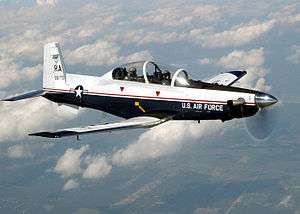Pilatus PC-9
| PC-9 | |
|---|---|
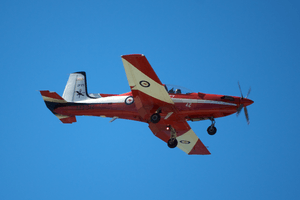 | |
| A RAAF PC-9 of 2FTS | |
| Role | Basic/Advanced Trainer aircraft |
| National origin | Switzerland, Australia |
| Manufacturer | Pilatus Aircraft |
| First flight | 7 May 1984 |
| Status | Active service in production |
| Primary users | Swiss Air Force Royal Australian Air Force Royal Saudi Air Force Royal Thai Air Force |
| Produced | 1984–present |
| Number built | 265 |
| Developed from | Pilatus PC-7 |
| Developed into | T-6 Texan II |
The Pilatus PC-9 is a single-engine, low-wing tandem-seat turboprop training aircraft manufactured by Pilatus Aircraft of Switzerland. Designed as a more powerful evolution of the Pilatus PC-7, the PC-9's first flight was made in May 1984 after which certification was achieved in September 1985. After this, the first production orders for the type were received from the Royal Saudi Air Force, with deliveries commencing in 1985. Since then, more than 250 airframes have been produced across five different variants and the type is employed by a number of military and civilian operators around the world, including the Swiss Air Force, the Royal Australian Air Force, and the Royal Thai Air Force.
Design and development
The PC-9 is a more powerful evolution of the PC-7. It retains the overall layout of its predecessor, but it has very little structural commonality with it. Amongst other improvements, the PC-9 features a larger cockpit with stepped ejection seats and also has a ventral airbrake.
The PC-9 program officially started in 1982. Although some aerodynamic elements were tested on a PC-7 during 1982 and 1983, the first flight of the first PC-9 prototype took place on 7 May 1984. A second prototype flew on 20 July of the same year; this prototype had all the standard electronic flight instrumentation and environmental control systems installed and was thus almost fully representative of the production version.
Certification was achieved in September 1985. By this time, the PC-9 had lost the Royal Air Force trainer competition to the Short Tucano. However, the marketing links that Pilatus built up with British Aerospace during the competition led to their first order from Saudi Arabia.
As of 2004, more than 250 aircraft of this type have been built.
Operational history
The first production aircraft for the Royal Australian Air Force (RAAF) flew on 19 May 1987, under the Australian designation PC-9/A.
Condor of Germany uses 10 examples of the target-towing variant.
In August 2015, Pilatus received a contract to deliver nine PC-9Ms to the Royal Jordanian Air Force, but in April 2016 changed the order to eight PC-21s. Deliveries were due to start in January 2017 under the original deal.[1]
Variants
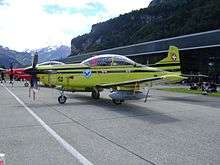
- PC-9
- Two-seat basic trainer aircraft.
- PC-9/A
- Two-seat basic trainer for the Royal Australian Air Force. Built under licence in Australia by Hawker de Havilland.
- PC-9B
- Two-seat target-towing aircraft for the German Air Force. This target-towing version has an increased fuel capacity enabling flight for up to 3 hours and 20 minutes as well as two Southwest RM-24 winches under the wings. These winches can reel out a target up to 3.5 kilometres.
- PC-9M
- This version was introduced in 1997 as the new standard model. It has an enlarged dorsal fin in order to improve longitudinal stability, modified wingroot fairings, stall strips on the leading edges as well as new engine and propeller controls. Croatia bought 17 new examples in 1997; Slovenia placed an order for nine (nicknamed Hudournik – "Swift") in December of the same year; Oman ordered 12 examples in January 1999; and Ireland signed a contract for eight in January 2003. Bulgaria purchased 12 aircraft in 2004. The last order was made by Mexico, which received at least two in September 2006.
- Beech Pilatus PC-9 Mk.2
- In order to compete in the United States JPATS competition, Pilatus and Beechcraft developed an extensively modified version of the PC-9, initially called the Beech Pilatus PC-9 Mk. II which won out over seven other contenders.[2] It was later renamed the Beechcraft T-6A Texan II and is now built and marketed independently by Beechcraft. Over 700 are to be built for the United States Air Force and United States Navy, with Pilatus receiving royalties.
Operators



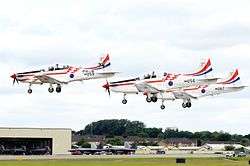
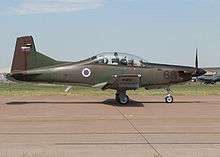

Military operators
- Royal Australian Air Force operates 67 aircraft – two were supplied directly by Pilatus, 17 were assembled from Pilatus-supplied kits and 48 were built in Australia by Hawker de Havilland. The type is also used by the Roulettes aerobatic display team of the RAAF.[3]
- Bulgarian Air Force operates six aircraft delivered in 2004.
- Croatian Air Force operates 20 aircraft – 17 PC-9M delivered new from 1997, as well as three second-hand examples. PC-9s are used for advanced pilot training and as a national aerobatic aircraft in a group called Wings of Storm.
- Chadian Air Force operates three PC-7s and one PC-9. The latter was delivered to Chad to replace a PC-7 which it had purchased from France.[4]
- Irish Air Corps operates seven PC-9Ms delivered in late 2004. In 2005, the aircraft were upgraded and each aircraft is now equipped with two rocket pods and two machine gun pods. On 12 October 2009, a PC-9M was involved in a fatal crash near Cornamona, in County Galway, which killed both pilots.[5]
- Mexican Air Force received two aircraft in 2006.
- Myanmar Air Force received 10 aircraft delivered from April 1986.
- Royal Air Force of Oman operates 12 aircraft delivered from 1999 to March 2000.
- Royal Saudi Air Force operates 50 aircraft delivered from December 1986. These examples were sold via British Aerospace.
- Slovenian Air Force and Air Defence operates 9 aircraft, designated PC-9M Hudournik. Three aircraft delivered from 1995 (one was lost in a crash in 2004) and nine aircraft delivered from November 1998. These examples have been upgraded by RADOM Aviation in Israel. Two outdated versions (PC-9A) were sold via auction in the end of year 2015.[6]
- Swiss Air Force operates 14 aircraft delivered from 1987. Two returned to Pilatus after evaluation.
- Royal Thai Air Force operates 23 aircraft delivered from 1991. The type is also used by the Blue Phoenix aerobatic display team.
Former military operators
- United States Army operated three PC-9s from 1991–96 as chase and test aircraft. They were sold to Slovenia in 1995.[7]
Civil operators
- Condor Flugdienst operated 10 aircraft for target-towing duties.
- BAE Systems operated two development aircraft in support of the Royal Saudi Air Force contract.
Specifications (PC-9M)
Data from Jane's All The World's Aircraft 2003–2004[8]
General characteristics
- Crew: one or two pilots
- Length: 10.14 m (33 ft 3 in)
- Wingspan: 10.125 m (33 ft 3 in)
- Height: 3.26 m (10 ft 8 in)
- Wing area: 16.29 m2 (175.3 sq ft)
- Empty weight: 1,725 kg (3,803 lb)
- Gross weight: 2,350 kg (5,181 lb)
- Max takeoff weight: 3,200 kg (7,055 lb)
- Powerplant: 1 × Pratt & Whitney Canada PT6A-62 turboprop, 857 kW (1,149 hp) flat-rated at 708 kW (950 shp)
Performance
- Maximum speed: 593 km/h (368 mph; 320 kn)
- Cruising speed: 556 km/h (345 mph; 300 kn) at 7,620 m (25,000 ft)
- Stall speed: 143 km/h (89 mph; 77 kn) EAS flaps and gear up, 128 km/h (80 mph; 69 kn) flaps and gear down
- Range: 1,537 km (955 mi; 830 nmi)
- Endurance: 4 hr 30 min
- Service ceiling: 11,580 m (37,992 ft)
- g limits: + 7.0 g to −3.5 g
- Rate of climb: 20.8 m/s (4,090 ft/min)
- Take-off distance over 50 ft (15 m) obstacle at sea level: 1,280 ft (391 m)
- Landing distance over 50 ft (15 m) obstacle at sea level: 2,295 ft (700 m)
Armament
- Hardpoints: Three hardpoints under each wing, inner two rated at 250 kg (550 lb), outer rated at 110 kg (240 lb)
See also
- Related development
- Aircraft of comparable role, configuration and era
References
Notes
- ↑ "Jordan amends Pilatus order to take PC-21 trainers". FlightGlobal. 11 April 2016.
- ↑ Eddie Torson (March 1993). "Beech's J-PATS Candidate Reaches The Final Phase of Testing". Air Progress.
- ↑ "RAAF Aircraft PC-9." airforce.gov.au. Retrieved: 9 November 2012.
- ↑ Goebel, Greg. "Pilatus Turbo-Trainers." airvectors.net. Retrieved: 9 November 2012.
- ↑ "Two pilots die in Air Corps crash." RTÉ News. Retrieved: 9 November 2012.
- ↑ "Who bought Slovenian army planes and paid 1,3 million euros for them (In slovenian language)". Retrieved 1 May 2016.
- ↑ Harding 1997, p. 202.
- ↑ Jackson 2003, pp. 455–456.
Bibliography
- Harding, Stephen. U.S. Army Aircraft Since 1947. Atglen, Pennsylvania: Schiffer Publishing Ltd., 1997. ISBN 978-0-76430-190-2.
- Jackson, Paul. Jane's All The World's Aircraft 2003–2004. Coulsdon, UK: Jane's Information Group, 2003. ISBN 0-7106-2537-5.
External links
| Wikimedia Commons has media related to Pilatus PC-9. |
